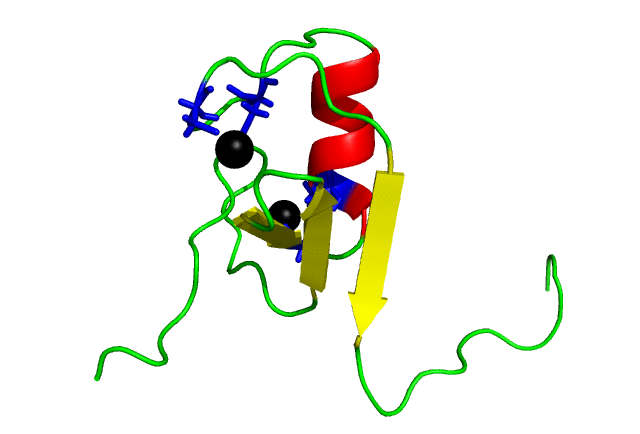Symbol zf-C3HC4 InterPro IPR001841 PROSITE PDOC00449 | Pfam PF00097 SMART SM00184 SCOP 1chc | |
 | ||
In molecular biology, a RING (Really Interesting New Gene) finger domain is a protein structural domain of zinc finger type which contains a C3HC4 amino acid motif which binds two zinc cations (seven cysteines and one histidine arranged non-consecutively). This protein domain contains from 40 to 60 amino acids. Many proteins containing a RING finger play a key role in the ubiquitination pathway.
Contents
Zinc fingers
Zinc finger (Znf) domains are relatively small protein motifs that bind one or more zinc atoms, and which usually contain multiple finger-like protrusions that make tandem contacts with their target molecule. They bind DNA, RNA, protein and/or lipid substrates. Their binding properties depend on the amino acid sequence of the finger domains and of the linker between fingers, as well as on the higher-order structures and the number of fingers. Znf domains are often found in clusters, where fingers can have different binding specificities. There are many superfamilies of Znf motifs, varying in both sequence and structure. They display considerable versatility in binding modes, even between members of the same class (e.g. some bind DNA, others protein), suggesting that Znf motifs are stable scaffolds that have evolved specialised functions. For example, Znf-containing proteins function in gene transcription, translation, mRNA trafficking, cytoskeleton organisation, epithelial development, cell adhesion, protein folding, chromatin remodelling and zinc sensing. Zinc-binding motifs are stable structures, and they rarely undergo conformational changes upon binding their target.
Some Zn finger domains have diverged such that they still maintain their core structure, but have lost their ability to bind zinc, using other means such as salt bridges or binding to other metals to stabilise the finger-like folds.
Function
Many RING finger domains simultaneously bind ubiquitination enzymes and their substrates and hence function as ligases. Ubiquitination in turn targets the substrate protein for degradation.
Structure
The RING finger domain has the consensus sequence C-X2-C-X[9-39]-C-X[1-3]-H-X[2-3]-C-X2-C-X[4-48]-C-X2-C. where:
The following is a schematic representation of the structure of the RING finger domain:
x x x x x x x x x x x x x x x x x x C C C C x \ / x x \ / x x Zn x x Zn x C / \ H C / \ C x x x x x x x x x x x x x x x x xExamples
Examples of human genes which encode proteins containing a RING finger domain include:
AMFR, BBAP, BFAR, BIRC2, BIRC3, BIRC7, BIRC8, BMI1, BRAP, BRCA1, CBL, CBLB, CBLC, CBLL1, CHFR, COMMD3, DTX1, DTX2, DTX3, DTX3L, DTX4, DZIP3, HCGV, HLTF, HOIL-1, IRF2BP2, KIAA1542, LNX1, LNX2, LOC51136, LONRF1, LONRF2, LONRF3, MARCH1, MARCH10, MARCH2, MARCH3, MARCH4, MARCH5, MARCH6, MARCH7, MARCH8, MARCH9, MDM2, MEX3A, MEX3B, MEX3C, MEX3D, MGRN1, MIB1, MID1, MID2, MKRN1, MKRN2, MKRN3, MKRN4, MNAT1, MYLIP, NFX1, NFX2, PCGF1, PCGF2, PCGF3, PCGF4, PCGF5, PCGF6, PDZRN3, PDZRN4, PEX10, PJA1, PJA2, PML, PML-RAR, PXMP3, RAD18, RAG1, RAPSN, RBCK1, RBX1, RC3H1, RC3H2, RCHY1, RFP2, RFPL1, RFPL2, RFPL3, RFPL4B, RFWD2, RFWD3, RING1, RNF2, RNF4, RNF5, RNF6, RNF7, RNF8, RNF10, RNF11, RNF12, RNF13, RNF14, RNF19A, RNF20, RNF24, RNF25, RNF26, RNF32, RNF38, RNF39, RNF40, RNF41, RNF43, RNF44, RNF55, RNF71, RNF103, RNF111, RNF113A, RNF113B, RNF121, RNF122, RNF123, RNF125, RNF126, RNF128, RNF130, RNF133, RNF135, RNF138, RNF139, RNF141, RNF144A, RNF145, RNF146, RNF148, RNF149, RNF150, RNF151, RNF152, RNF157, RNF165, RNF166, RNF167, RNF168, RNF169, RNF170, RNF175, RNF180, RNF181, RNF182, RNF185, RNF207, RNF213, RNF215, SH3MD4, SH3RF1, SH3RF2, SYVN1, TIF1, TMEM118, TOPORS, TRAF2, TRAF3, TRAF4, TRAF5, TRAF6, TRAF7, TRAIP, TRIM2, TRIM3, TRIM4, TRIM5, TRIM6, TRIM7, TRIM8, TRIM9, TRIM10, TRIM11, TRIM13, TRIM15, TRIM17, TRIM21, TRIM22, TRIM23, TRIM24, TRIM25, TRIM26, TRIM27, TRIM28, TRIM31, TRIM32, TRIM33, TRIM34, TRIM35, TRIM36, TRIM38, TRIM39, TRIM40, TRIM41, TRIM42, TRIM43, TRIM45, TRIM46, TRIM47, TRIM48, TRIM49, TRIM50, TRIM52, TRIM54, TRIM55, TRIM56, TRIM58, TRIM59, TRIM60, TRIM61, TRIM62, TRIM63, TRIM65, TRIM67, TRIM68, TRIM69, TRIM71, TRIM72, TRIM73, TRIM74, TRIML1, TTC3, UHRF1, UHRF2, VPS11, VPS8, ZNF179, ZNF294, ZNF313, ZNF364, ZNF650, ZNFB7, ZNRF1, ZNRF2, ZNRF3, ZNRF4, and ZSWIM2.
